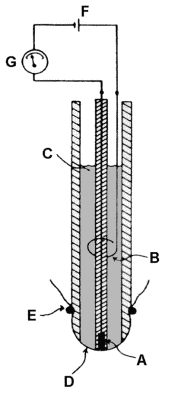Clark electrode

The Clark electrode [1][2] is an electrode that measures oxygen on a catalytic platinum surface using the net reaction:
- O2 + 4 e− + 2 H2O → 4 OH−
It improves on a bare platinum electrode by use of a membrane to reduce fouling and metal plating onto the platinum.[3]
History
Leland Clark (Professor of Chemistry, Antioch College, Yellow Springs, Ohio, and Fels Research Institute, Yellow Springs, Ohio) had developed the first bubble oxygenator for use in cardiac surgery. However, when he came to publish his results, his article was refused by the editor since the oxygen tension in the blood coming out from the device could not be measured. This instigated Clark to develop the oxygen electrode.[4]
The electrode, when implanted in vivo, will reduce oxygen and thus required stirring in order to maintain an equilibrium with the environment. Severinghaus improved the design by adding a stirred cuvette in a thermostat. A discrepancy between the measured partial pressure of oxygen (pO2) between blood samples and gaseous mixtures of identical pO2, the modified electrode required calibration; consequently a microtonometer was added to the water thermostat.[4]
- O2 + 2 H+ + 2e− → H2O2
Application
Electron flow to oxygen as a result of oxidative phosphorylation can be demonstrated using an oxygen electrode. The electrode compartment is isolated from the reaction chamber by a thin Teflon membrane; the membrane is permeable to molecular oxygen and allows this gas to reach the cathode, where it is electrolytically reduced.[5]
The reduction allows a current to flow; this creates a potential difference which is recorded on a flatbed chart recorder. The trace is thus a measure of the oxygen activity of the reaction mixture. The current flowing is proportional to the activity of oxygen provided the solution is stirred constantly (stir bar) to minimize the formation of an unstirred layer next to the membrane.[5] A typical field of application is closed chamber respirometry.
References
- ↑ Clark Jr, LC; Wolf, R; Granger, D; Taylor, Z (1953). "Continuous recording of blood oxygen tensions by polarography". Journal of applied physiology. 6 (3): 189–93. PMID 13096460.
- ↑ Severinghaus, JW; Astrup, PB (1986). "History of blood gas analysis. IV. Leland Clark's oxygen electrode". Journal of clinical monitoring. 2 (2): 125–39. doi:10.1007/BF01637680. PMID 3519875.
- ↑ KANWISHER, JOHN (1959). "Polarographic oxygen electrode" (PDF). Limnology and Oceanography. 4 (2): 210–217. doi:10.4319/lo.1959.4.2.0210.
- 1 2 Severinghaus J. The Invention and Development of Blood Gas Analysis Apparatus. Anesthesiology. 2002;97:253-6
- 1 2 Trinity College Dublin, Biochemistry Laboratory Manual for Senior Freshman Science, 2005-2006. www.tcd.ie/biochemistry
External links
- Clark-type Sensors Explained, The Gas Detector Encyclopedia, Edaphic Scientific Knowledge Base
- Biosensors & Bioelectronics: Leland Clark
- Clark Oxygen Electrode, precursor to today's modern biosensors - broken link